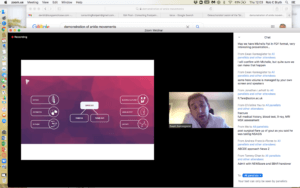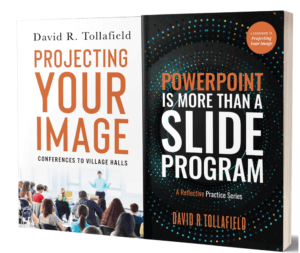Webinars Good or Bad?
No one in the world of communication can have failed to appreciate that the internet has come of age during lockdown. So, are Webinars the new lecture forum? This article considers this question for podiatrists and methods of supporting continuous learning. I will look at smaller webinars rather than the big conference productions now seen online and produced professionally.
All contact venue conferences ceased during 2020, and even those planned months ahead were sent into chaos. It is hard to imagine the cost to companies hoping to promote their brands. People who meet at conferences rely on that special contact that allows business and knowledge to flourish. I was invited to five conferences and branch meetings during 2020. All of this planning went out the window. Many systems have been developed for business rather than seen as social systems like Zoom. Zoom, in particular, has taken advantage of families wanting to stay in touch nationally or internationally. YouTube does provide a service for live conferencing. The two podiatry organisations, The College and The Institute, run different presentation products.
This article was based on a small section of my Projecting Your Image book. Conferences to Village Halls.
The Future of Webinars

Grab a coffee and sit back with your notepad in the warmth of your own house.
The principles behind public speaking are unlikely to change. Technology moves rapidly, introducing us to new communication methods. The idea of presentations being committed to video streaming, once a dream, is now possible. YouTube ranks top with Google Hangouts, Live Stream, Vimeo Live, and Infiscene, among many others. I made a 10-minute video for one conference, which I can share and is now connected to my December (2020) Newsfeed. This was launched through YouTube. However, a new generation of software media was produced or even expanded during this period when we were all out of commission.
Choices
Team Viewer, Zoom, Mitel’s Micollab, Cisco webbed, Goto meeting, join.me, Team Viewer, and Microsoft Teams are just some of the wide range of examples of web conferencing systems. An uploaded video works well but does not always connect easily with the conference systems.
Webinar as a seminar
Webinars are popular, and webcasts can be turned into seminars. Feedback and questions are fed back to the speaker and validated before they appear at the side of the image on the computer screen. This allows people to see incoming questions. Webinars usually run for 20 minutes but can be extended. The length of time and number of attendees depend upon the cost of the online service. With Zoom, this is usually 40-60 minutes for the free version and for smaller audiences, while subscriptions open up more facilities. The Royal College’s conferences will be arranged on an organisational basis, for which there will be a fee. Larger conference systems have an on cost.
The Southern Deanery Webinar
 I was delighted to attend, well I mean virtually, the Southern Deanery (College of Podiatry, Faculty of Podiatric Surgery, meeting on Thursday, 3rd December. This was expertly chaired, and using slides and speakers raised the value of such educational meetings. Adapting the screen from small to large options gave flexibility. The questions posed by delegates are placed on the right-hand side. Slides are shown next to the speaker, and the delegates are invited to make screen grabs (as illustrated). No doubt, the next Podiatry Now will cover the experience. Such an undertaking will not be as simple as local or regional webinars.
I was delighted to attend, well I mean virtually, the Southern Deanery (College of Podiatry, Faculty of Podiatric Surgery, meeting on Thursday, 3rd December. This was expertly chaired, and using slides and speakers raised the value of such educational meetings. Adapting the screen from small to large options gave flexibility. The questions posed by delegates are placed on the right-hand side. Slides are shown next to the speaker, and the delegates are invited to make screen grabs (as illustrated). No doubt, the next Podiatry Now will cover the experience. Such an undertaking will not be as simple as local or regional webinars.
My immediate critique delivered a positive reflection on this clinical meeting. The speakers I saw spoke well, and their material was presented effectively with good-quality slides. The Chair, Ewan Kannegieter, provided advice about the slide programme favoured by the Southern Deanery. These were known as Pulse Notes. Click on the blue to find out more.
Live presentations, Videos and Podcasts

Talking to podiatrists in Johannesburg in 2014
I must admit that I prefer a real audience when speaking. That doesn’t mean I’m not open to new ideas. I have made some self-help films, largely for my book on bunions. I have added a couple of audio podcasts; you can listen to them on PodBean. The principles are similar but have no audience interaction.
Online presentations should be short, but webinars with interaction can be much longer. Webinars are often a free resource. However, beware. There is usually a sales pitch somewhere along the line, so it is important not to be caught out.
Making a dummy run (only blue colours are uploadable)
 I decided to put my 10-minute presentation on YouTube as it allowed me to practise my talk. As I mentioned in my book, practice is important as the talk is time-dependent and should always be observed by the speaker. One of the important ingredients of public speaking is knowing what you will say, how you intend to say it and how long you need to allocate the presentation. It does not matter whether you are doing a presentation live or by any other medium.
I decided to put my 10-minute presentation on YouTube as it allowed me to practise my talk. As I mentioned in my book, practice is important as the talk is time-dependent and should always be observed by the speaker. One of the important ingredients of public speaking is knowing what you will say, how you intend to say it and how long you need to allocate the presentation. It does not matter whether you are doing a presentation live or by any other medium.
By undertaking a dummy run, you can see some of the flaws that can creep in. I will let you identify the flaws that I have left out as a training video. My watchword is ‘REFLECTION!’ Before Lockdown, most of us had not seen the potential for ZOOM. I’ll return to Zoom shortly, but I continued to believe the traditional way of setting up a lecture online was to make a film. This is then edited using a video suite and then uploaded in the correct format to a platform such as YouTube. You can upload it and publish your own lecture or talk without travelling around the country. This has many advantages, but you will lose that personal connection with your audience. Live presentations will always win out as they retain a sense of human frailty that we all have. Zoom (read any of those web conferencing methods above) can provide this same medium, but it is important to have a structure.
CRITIQUE: Bad Bits over the Good
Chaos online
(1) When sitting in on a webinar, I noted that the speaker relied on the attendees (audience) who were sitting at home on their computers. The participants were texting each other, and no one was particular. One could see the questions on the side of the screen as they were off-the-wall comments. I sat in on this rather disastrous webinar. The speaker was mature and experienced and gave advice as an editor. The webinar was about writing. However, she made one vital mistake that wrecked the whole hour-long tutorial. I left the (virtual) room at 25 minutes because I placed a high value on my time and could see the audience had run away in chaos. This is the advantage of watching something at home; you can leave, make a cup of coffee, or meet another requirement and come back. As a presenter, you want to keep your audience together.
(2) A recent webinar used multiple speakers. The lead came to the feed late, and then the webinar descended into a lengthy self-gratification of past memories between the presenters. Workshops with live contact can suffer from the same problem if not properly led. Sessions comprise a series of talks, often running along a common theme that may be led by a Chair. The chair is the controller of questions for a webinar. The speaker needs to be free to concentrate on questions fed in by the controller or by addressing the written queries the audience will have typed.
Texting in
Texting questions as the audience listens does not interrupt the talk. As the speaker progresses, each type of question lags behind in real-time. The audience can see these rolling down to one side of the screen. The audience often writes about something they feel a passion for. Some like to write without any clear rationale, and some questions can become asinine. Texting is both a strength and weakness of the webinar because distraction arises. While the audience may get an answer, the quality of the answer can depend on the controller or chair using that question. For the most part, speakers don’t dip into the questions, although I did a webinar with one group and saw a question that I thought was relevant and wanted included. The meeting relies on those questions if the interactive webinar and the seminar are designed.
Chairing meetings at live conferences is a little different and should abide by the same rules.
A new idea for branches?
Loom & PowerPoint
My daughter, an educationalist, suggested Loom to me after talking about Zoom. I set this up as it allows a similar method to YouTube. The basic package is free, and I wanted to try it out. The latter method that I used required a video suite to edit my PowerPoint slides (mentioned earlier). This can be quite a lengthy process. Loom allows you to put your PowerPoint together as you would a normal talk. In other words, you make your PowerPoint slide show up and import it into Loom.
Kathleen Morris explains Loom a little more. On this site, the usual plethora of adverts don’t appear!
I had a go with Loom after cancelling a live branch lecture. We decided that I would create a Loom talk using PowerPoint. This was timed at 30 minutes, and then I created a Zoom meeting to discuss the content. All went well. The Loom was password-protected and used exclusively by the group. At the allotted time, we connected, but the group missed the link and did not digest the material beforehand. I delivered the Zoom to our small group. Socially distancing of course. Through reasonable preparation, I could talk off the cuff, as I did not know what to expect. These can become hair-raising moments initially. Certainly, I hope we will not see the demise of the formal lecture or conference, for that would be a tragedy. However, learning how to present is important even with this new medium.
You can order my book on public speaking from Amazon NOW.
Reflection on webinars
 In case (1), the organiser had relied too much on audience participation. When this wasn’t forthcoming, she didn’t have enough material. She kept repeating the same things until she became completely lost in a cycle of unhelpful repetition. Trying to claw back into their favour if you lose your audience can be an uphill challenge. No one had told the audience THAT THEY WERE DRIVING THE MATERIAL!
In case (1), the organiser had relied too much on audience participation. When this wasn’t forthcoming, she didn’t have enough material. She kept repeating the same things until she became completely lost in a cycle of unhelpful repetition. Trying to claw back into their favour if you lose your audience can be an uphill challenge. No one had told the audience THAT THEY WERE DRIVING THE MATERIAL!
In case (2), well, it was just disorganised chaos. If you wanted chit-chat, fine. I would like to have clear goals for my talks. In my own case, I tried to assure myself I achieved what I had set out in the Loom presentation. I re-sent the Link so the branch group could still go back over the talk. I had missed sections, but this was due to time constraints and the fact that Zoom was cut out several times. The group did well in keeping the momentum going. The webinar has more plusses, which will grow in time and replace many formal conferences and smaller meetings. This was already happening, but the rate of change has expanded since Lockdown No.1.
GOOD
- No travelling. This is good for the environment.
- Well-organised webinars are as good as old-style lectures.
- The technology has reached a reliable level and can be supported by external (paid-for) resources, saving time.
- You can plan and deliver a message effectively using quality images for the speaker.
- There are many such web conference platforms on the market, many are free to develop speaker skills eg Loom.
- Time constraints can be better adhered to, making the presentation more efficient.
- Pre-prepared webinars that can be downloaded after the date of the initial launch make for better timetabling and can be repeated.
- If you can present live, then presenting on the webinar is a transferable skill.
BAD
- Poor organisation limits the value of any presentation.
- The lack of direct interaction can inhibit many speakers.
- Too much interaction can create chaos.
- Internet connections can affect many locations, especially in rural areas.
Resources
Now available in paperback with a companion.
Projecting Your Image. From Conferences to Village Halls
PowerPoint is more than a slide programme
Thanks for reading this article, ‘Webinars Good or Bad?’
Written by David R. Tollafield
Published by Busypencilcase Reflective Communications Est. 2015

Originally published 5th December 2020. Updated 7 May 2024




Recent Comments